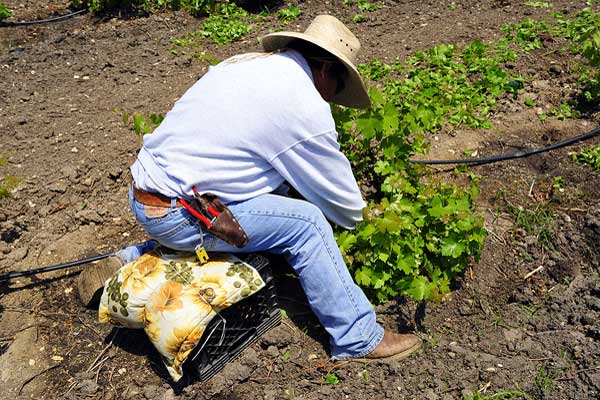
Who are Canada's migrant workers?
Published: February 28, 2012
On Feb. 6, in a collision between a van and a truck on a rural road near Stratford, Ontario, 11 people died, 10 of them temporary agricultural workers. Most were from Peru. With this horrific crash, the eyes of many Canadians were opened to a little-known sector of the Canadian workforce – migrant workers.
In this interview, U of T’s Jeffrey Reitz, R.F. Harney Professor of Ethnic, Immigration and Pluralism Studies at the Munk School of Global Affairs, provides insight into the conditions facing temporary workers in Canada.
Who are migrant workers in Canada?
When you mention "migrant workers," that’s not a category that exists in the Canadian immigration program. There are, in fact, several programs that bring in workers on a temporary basis.
The workers who were involved in this accident were here as part of the Seasonal Agricultural Worker Program (SAWP). This is an immigration program involving employers in agricultural industries who seek to bring in workers from other countries, particularly Latin America and the Caribbean, to do work on seasonal basis.
Tens of thousands of workers come into Ontario every year to work in harvesting crops, such as tomatoes in the Leamington area or grapes for the Niagara wine industry, from March through to November. These workers are mostly Mexicans. They do all the field work in producing wine in Ontario. That’s been in place for a number of years and there are approximately 20,000 to 25,000 workers coming into the country every year through this program.
It’s been regarded as a success despite the fact that the rates of pay are low, benefits are limited and the workers live under regimented circumstances. But from the point of view of employers, it’s a great success because the workers come in, work hard and are easier to train than Canadian applicants for similar jobs. These workers also generally leave the country when the season is over, and they are frequently invited back for subsequent seasons. According to the government, the compliance rate with the visa provisions is 99.9 per cent .
What are the other programs?
We also have other programs available to bring in workers on a longer temporary basis, such as two years, and renewable on a limited basis. The Temporary Foreign Worker Program (TFWP) is open to employers across the country in a variety of industries, for example, the oil and construction industries. And the numbers entering the country each year have risen substantially from maybe about 100,000 10 years ago to nearly 200,000 today.
In terms of skill levels, whereas the SAW program is for workers who have low levels of education by Canadian standards and who are employed almost exclusively in manual work, those in the TFW program include workers at all skill levels from professionals to manual workers. The federal government doesn’t publish complete statistics on the skill levels, but it’s a much more diverse program.
We have thousands of people coming here to do this work. At the same time, we have thousands of people in Canada who are unemployed. Why don’t the Canadians do this work?
Let’s look at the SAW program. First, rates of pay are low. For the Mexicans coming in, the rate is something like five times the Mexican average, so those folks are making good money from a Mexican standpoint. They spend almost nothing here and they live in regimented conditions so it is, from their point of view, an economic advantage.
But from the point of view of the Canadian workers, it’s a very low rate of pay so you tend to get people with very little education or career prospects and from the lower end of the socio-economic hierarchy. In the case of the Mexicans, they come from higher in the Mexican socio-economic hierarchy and their work habits reflect that higher status. If you talk to the vintners in Niagara, they’ll say if you hire Canadians, the problem is that they won’t stay the whole season or show up for work on a regular basis. And they’ll say that with the Mexicans, they get very reliable, hard working, intelligent people who will do a good job.
So it isn’t only that Canadians won’t take the work because of the low pay, it’s that those people who would be interested in those jobs at those rates of pay are simply not as reliable and aren’t as easy to train.
Still, it sounds as if this work is beneficial to the workers and Canadian industry.
Yes, it can be, but it’s important to remember that the working conditions are problematic. Historically, getting access to benefits, such as health care, has been difficult. But even where there is access, I think many of those workers are reluctant to make use of it because they don’t want to be a problem. They want to be invited back next year. So some of them will be injured but will work with the injury. Or if they have a complaint and are mistreated by the employer, they’ll probably just suck it up. So the employers have a real position of control.
Are there other problems?
There is a concern with the Temporary Foreign Worker program that since the jobs are in urban areas and not in regimented rural circumstances where people are easier to control, knowing when those people have left the country is an issue. The government will express confidence that the rules are being followed, but their capacity to monitor the program compliance is limited. If you look at the experiences in other countries, everywhere there has been a temporary foreign worker program, there’s been a problem with visa compliance. There is also the problem of employers being in a position potentially to exploit the vulnerability of the workers.
For example, in the construction industry in Toronto, some of those workers have the possibility after a period of time to apply for permanent status. So the employer is in a position of a significant amount of power. Workers can be asked to work overtime with no extra pay, for example. And they’re very disinclined to turn down the employer for fear that they might lose their jobs within months of being eligible to become permanent residents.
So there’s an element of risk of employers abusing workers.
I know there’s a tendency to say ‘These are Canadians, they won’t abuse the workers,’ but we shouldn’t completely discount the possibility that employers are trying to make money and at least some of them could take advantage of the situation. Research now underway by some of my colleagues here at the University of Toronto indicates that these experiences definitely occur.
This is similar to complaints that have been made about the live-in caregiver program, another type of program that employs temporary foreign workers. These are people who come to Canada and work in domestic settings, hoping at the end of that time that they will become permanent residents of Canada. Many of them are nurses back home and they use this as a way of getting around the longer line for independent immigrants. But the concern is that the employers can take advantage, particularly since the employee is living in a domestic situation. This has been a longstanding concern in that program and it’s very difficult to monitor it.
I was going to ask you about monitoring. Does the government have a way of ensuring the workers are being treated fairly?
No. Neither party – either employee or employer – is really comfortable with providing the government with information. Why would an employer provide information that might lead them to being prosecuted? And for the workers, they run the risk of losing the support of the employer. So not only is the information difficult to collect but the people who have the information are reluctant to provide it. For that reason, we don’t really know much about what goes on. You hear stories and they can be heart-wrenching but what you need to know from a policy standpoint is how prevalent these things are and that’s something for which we’ve never really had good information.
Is there ever a concern of privatizing this activity?
Generally, the move has been to giving employers a greater role in determining who gets into the country. The concern, of course, is that whenever you privatize any kind any kind of government program you have to make sure the government’s objectives in the program are actually being met. And sometimes we tend to overlook that aspect, because in seeking privatization, the government wants to reduce bureaucracy, so it doesn’t want to set up a new bureaucracy to monitor the behaviour of some private sector people who are doing something that’s been done in the public sector.
But the monitoring is still important. We are finding that out in the case of the helicopter ambulance service in Ontario, that when you privatize but you’re not monitoring and you take the word of the employer, you can be very disappointed with what can happen. That’s why I think it’s well worthwhile, as changes are introduced to the immigration program, that we monitor how they work. If problems arise, they may not do so for a number of years.
Are the Canadian programs different from those in other countries?
Yes and that’s a problem in itself. A lot of people would like to see improvements in terms of access to services for temporary workers and the ability of people to make complaints about poor treatment. But that hasn’t attracted a lot of attention, partly because compared to programs in other countries, such as in the U.S., the Canadian programs are much better organized.
In the United States, most temporary foreign workers are unauthorized, and the system is essentially laissez faire. The workers come in without government authorization, there’s a lot of danger involved there, and rates of pay may be worse in many cases. There’s no stable employment and getting back home is risky, so compared to the use Americans make of agricultural Mexicans, our program looks fabulous and therefore has attracted little attention.



